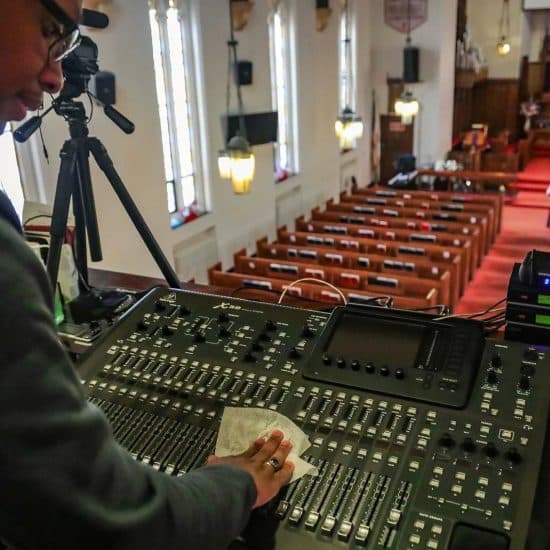
The socio-economic realities of local churches, denominational groups, para-church organizations, and all other forms of non-profit institutions have shifted dramatically in the wake of the COVID-19 pandemic. Demands for services and programs like food banks, housing assistance, and the need for mental and spiritual health care have increased dramatically. Compounding this issue, as needs increase traditional streams of revenue that supported congregations and other caregiving services are in decline.

Greg Mamula
Places where people had historically been prompted to donate or support such groups were disrupted. Churches accelerated plans to foster hybrid and online worship, discipleship, and ministry models. Nonprofit charities limited access or completely altered their forward-facing care opportunities necessitating volunteers and employees to serve with important safety-conscious PPE or shift to online workplaces. Thankfully, a variety of stimulus packages, grants, legacy investments, and denominational support helped many congregations and nonprofits remain viable by helping fund pastoral and other employee salaries or supplement mission and ministry expenses.
While we are no longer at the peak of the pandemic stress, we are still amid a season of financial insecurity with a possible recession and rising inflation lurking in the background. So even though most of our churches and service-based charities are back to more familiar expressions of gathering and serving, the need to consider additional and different forms of revenue to support our ongoing mission and ministry is important.
This article is part of a series on the future of the church in which I am sharing six observations I think we need to focus on to be the faithful presence of Jesus over the next decade:
- Allow the full narrative of scripture to shape your holy imagination
- Learn to listen and respond well to your community
- Build more and better networks
- Recognize the gifts and talents of all people
- Invite people from isolation to inclusion
- Develop multiple revenue streams
Feel free to share with me your observations of what you see coming and where you feel the Spirit is leading.
Today we are going to focus on developing multiple revenue streams.
Develop multiple revenue streams.
Something to avoid in this conversation is what Reorganized Religion: The Reshaping of the American Church and Why it Matters author Bob Smietana calls the Hamlet Problem. “…churches have to understand the difference between things they can control and change and things they have to adapt to.” When churches and church leaders imagine themselves as the primary actors on the stage, they tend to focus on their own actions, believing that if they make all the best choices everything will fall into place. However, things like COVID, stock markets, wars, gas prices, shifting demographics, and other challenges that create fiscal uncertainty are largely beyond the control and power of our churches and church leaders. Even if we make excellent wise fiscal decisions, churches and denominations may still be unable to make a budget because of things outside of their control.
One of the questions we can ask going forward might be, “Are there multiple revenue streams beyond traditional giving patterns we can benefit from that will also help us achieve the mission and ministry of our local church, denomination, non-profit, etc.?”
Let’s begin by highlighting just a couple of the more familiar sources of church revenue that will continue to be a significant source of our ability to craft our budgets.
- Classic donations: There will continue to be people who choose to tithe a percentage of their annual incomes to their local church either through an offering moment in a worship service or through automated payments through banks or church tithe platforms and peer-to-peer sharing apps.
- Fundraisers: Churches, youth groups, and other church groups will continue to host potlucks, raffles, bake sales, wash cars, mow lawns, etc for special events or purposes.
- Legacy giving: Churches and denominations will continue to need to grow and leverage legacy giving. This is one of the strengths of having an institutional partner that may be an expert in raising and managing legacy funds for long-term growth and access to mission and ministry. About one-third of my organization’s annual budget comes from legacy gifts and long-term investments.

Konstantin Evdokimov / Unsplash
Within these well-loved rhythms of regular donating and special fundraising, I believe there are a few niche things churches can explore.
- Micro Giving: the practice of giving small amounts of money, typically of $10 or less, to support a specific project. Think of this like the bake sale, without having to host a bake sale. Micro giving has become increasingly popular due to convenience and accessibility. It is so easy to click a link and send a few dollars through a GoFundMe, Venmo, Cash App, or social media. I believe churches should tap more deeply into these low-level easy access generosity mediums. Create QR codes to donate through your website, leverage tithe apps like Tithe.ly, or create non-profit accounts on peer-to-peer payment platforms like Venmo and Cash App. Let people know about your various church ministries and tell them to donate just a few dollars to their favorite ministry through these apps.
- Broaden the scope of your fundraising efforts beyond your Sunday worship gathering. If you have a mission and ministry that connects with your city or region, ask people in your city and region to contribute. Set your micro-giving signs and QR codes at your events so guests and volunteers can easily see them. Even post these opportunities within service ministries like food banks, community gardens, jacket drives, baby boutiques, and diaper depots. We offer these things for free because we love our neighbors and our neighborhoods. People who volunteer and those who benefit from these services may want to give even just a few dollars to support the cause.
- Grants are going to be even more important going forward. Churches can apply for grants from denominational partners, foundations, government agencies, and even corporations if their mission matches the grant-giving purposes. If your mission involves helping parents, forming cooperative gardens, supporting affordable housing, equitable food distribution, mental health, reading programs, or any one of a thousand other things, chances are there is a grant for it. Grants require documentation, supervision, and accountability. However, they are also a great way to strengthen established ministries and start new ministries beyond operating budget costs.
- Fee-based services: Churches and denominations are allowed to offer fee-based services and keep their 501c3 status. You can offer counseling, education, and other training for an ethical, reasonable fee that can help make a service or program self-sustaining. We always want to give away as much as possible for free, but sometimes we will need to charge to keep ministries going. You might even find a generous single donor or collection of donors to supplement a ministry.
- Rental Income: Churches are probably the most underutilized buildings in your city. Providing space for people to use your building during the week can be a great way to invest in your community and provide inexpensive space for other non-profit organizations to operate. Finding ministry partners that fit the mission of your church will be important. But charging a reasonable and ethical rent is a great way to get the most out of your facility. Don’t forget about your parking lot and green spaces! Why not host food trucks, parking lot offices, basketball tournaments, little league practice, and native prairie or pollinator gardens to leverage all that blank space during the week?
This is not new. Churches have long been places for any number of local meetings from AA groups to school boards. But here is the thing — do not just be a benevolent landlord. We should be looking for ways to connect all of these groups to the larger life and mission of the church to share the love of God and the gospel of Jesus. I recently heard a story of a recovering addict whose group used space in a church who said, “They will let us use their basement but they don’t want us in the sanctuary.” WOW! What a painful confession. If our churches are going to host outside groups, we must be ready to welcome them into the sanctuary and join them at the table.
In addition to identifying fiscal revenue streams, churches should ponder how to maintain the overall health of the church. In the book Red Skies, Mark Deymaz writes an article “Disrupting Church Economics” where he calls for churches to create spiritual teams, social teams, and financial teams to help keep a balance within creating multiple revenue streams. Spiritual teams oversee the local church and ministries in traditional ways. Social teams work alongside the church to help facilitate the other 501c3 programs a church may be involved in like justice and compassion ministries. Financial teams would supervise other sustainable income that may fall outside of a 501c3 status, like if a church began to attract so much facility usage it might need to create a separate business as an event center which would require different supervision.
Pastors are probably not broadly equipped to manage and oversee multiple revenue streams in addition to their primary purpose of equipping the saints for their works of ministry. However, the people in the church may be. They are businesspeople, managers, event planners, supervisors, skilled craftsmen, and more. They should be allowed and encouraged to utilize every skill and gift they have for the health of the church. Every church will be unique in the ways it chooses to identify, supervise, and manage multiple revenue streams. It will require more of the church people to be involved in the day-to-day of the ministries. It may require that each ministry have its own unique leaders and various forms of revenue they manage separately from the general budget of the church.
These are just a few ideas. Some of them may not even be good ideas. What we cannot do is keep pressuring the people in the pews to simply give more. That is not a long-term solution. The larger reality is churches and denominations must create more space in their budgets for new and different revenue sources. Doing so might even broaden our ministry opportunities to share the gospel with others.
Rev. Dr. Greg Mamula is the Associate Executive Minister for the American Baptist Churches of Nebraska, and a contributing writer for Word&Way. He is the author of Table Life: An Invitation to Everyday Discipleship, published by Judson Press in print and e-reader versions from online distributors including Amazon. To learn more information visit www.table-life.org.






